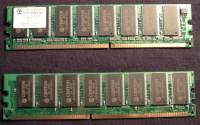
Mon-Fri 10am-6pm EST
Saturday 10am-5pm EST
Closed Sundays
|
DDR SDRAM or double-data-rate synchronous dynamic random access memory is a type of memory integrated circuit used in computers. It achieves greater bandwidth than ordinary SDRAM by transferring data on both the rising and falling edges of the clock signal (double pumped). This effectively nearly doubles the transfer rate without increasing the frequency of the front side bus. Thus a 100 MHz DDR system has an effective clock rate of 200 MHz when compared to equivalent SDR SDRAM, the “SDR” being a retrospective designation. JEDEC has set standards for speeds of DDR SDRAM, divided into two parts: The first specification is for memory chips and the second is for memory modules. |
|
||
|
With data being transferred 8 bytes at a time DDR RAM gives a transfer rate of (memory bus clock rate) × 2 (for dual rate) × 8 (number of bytes transferred). Thus with a bus frequency of 100 MHz, DDR-SDRAM gives a max transfer rate of 1600 MB/s. Chip specification Stick/module specification Note: All RAM speeds in-between or above these listed specifications are not standardized by JEDEC — most often they are simply manufacturer optimizations using higher-tolerance chips. The package sizes in which DDR SDRAM is manufactured are also standardised by JEDEC. There is no architectural difference between DDR SDRAM designed for different clock frequencies, e.g. PC-1600 (designed to run at 100 MHz) and PC-2100 (designed to run at 133 MHz). The number simply designates the speed that the chip is guaranteed to run at. Hence you can run DDR SDRAM at lower clock speeds than it was made for (underclocking) or higher clock speeds than it was made for (overclocking). Note that overclocking should only be done with high-quality memory and by those that know what they are doing (see overclocking for details on why). DDR SDRAM DIMMs have 184 pins (as opposed to 168 on SDRAM), and can be differentiated from SDRAM DIMMs by the number of notches (DDR SDRAM has one, SDRAM has two). DDR operates at a voltage of 2.5 V, compared to 3.3 V for SDRAM. This can significantly reduce power usage. Some new chipsets use these memory types in dual or even quad channel configurations, which doubles or quadruples the effective bandwidth. In the dual-channel configuration it is recommended to use a matched pair of memory modules to optimize performance. The modules in a pair have the same size, speed, and latency timings, enabling the chipset to interleave accesses with maximum efficiency. DDR is slowly being replaced by DDR-2, which has some modifications to allow higher clock frequency, but operates on the same principle as DDR. Competing with DDR-2 will be Rambus XDR-DRAM. It is expected that DDR-2 will become the standard, since QDR (Quad Data Rate) is too complex to implement, while XDR is lacking support. Memory manufacturers have stated that it is impractical to mass-produce DDR-1 memory with effective clock rates in excess of 400 MHz. DDR-2 picks up where DDR-1 leaves off, and is available at clock rates of 400 MHz and higher. |
|||
| "Here are the various used ram memory we have in stock." | ||
| 16mb EDO used Ram Memory | 32mb EDO used Ram Memory | 64mb EDO used Ram Memory |
| 32mb Sdram used Ram Memory | 64mb Sdram used Ram Memory | 128mb Sdram used Ram Memory |
| 256mb Sdram used Ram Memory | 512mb Sdram used Ram Memory | 1gig Sdram used Ram Memory |
| 128mb DDR used Ram Memory | 256mb DDR used Ram Memory | 512mb DDR used Ram Memory |
| 128mb Laptop used Ram Memory | 256mb Laptop used Ram Memory | 512mb Laptop used Ram Memory |


